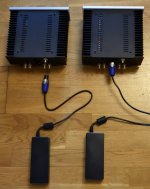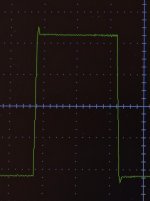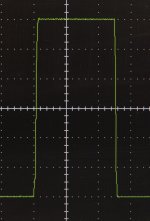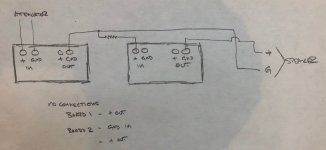So the ACA despite being Class A isn't hugely power hungry. Could you run it from batteries provided they could deliver the amps?
Theoretically there's no reason why not, as far as I can tell. You'd want to ensure that the Amp hour rating of the battery pack delivers sufficient endurance and then make sure that the voltage is regulated bang on the money for the bias setting of the amp.
How that practically converts to reality, I don't have the knowledge/experience to say. However I have a vague recollection of a post on here where a DIY'er was planning on doing an ACA for their caravan/boat, so I'd expect that you will not be the first to want to do this.
A minor point lacking technical know how to explain it, but just consider the amount of heat these amps produce while in operation. I wonder the size of the battery pack you might need to operate the ACAs directly from batteries. Perhaps you could buy a wrecked Prius and use its battery pack?
A minor point lacking technical know how to explain it, but just consider the amount of heat these amps produce while in operation. I wonder the size of the battery pack you might need to operate the ACAs directly from batteries. Perhaps you could buy a wrecked Prius and use its battery pack?
Nothing anywhere near as big required more like this:
15% OFF - 1/2kw (500w) - 7 Board PCB V1.3 Ready To Build
– Jehu's Group Buy
ACA sings first song without smoke!
YouTube
I have received the kit couple of months ago but only have time this week to build it.
Enjoyed the building process with all information from the website, no smoke.
Played the first song with iPhone + 90th Sony speakers all good.
Then moved to the main system, it sounds very good, smooth and pure. The Schiit Magni 3 may not be a good match used as preamp, thinking about an upgrade soon.
YouTube
Both recorded with iPhone.
YouTube
I have received the kit couple of months ago but only have time this week to build it.
Enjoyed the building process with all information from the website, no smoke.
Played the first song with iPhone + 90th Sony speakers all good.
Then moved to the main system, it sounds very good, smooth and pure. The Schiit Magni 3 may not be a good match used as preamp, thinking about an upgrade soon.
YouTube
Both recorded with iPhone.
Both my ACAs pull about 72 VA when warmed up. So at 24 V, that equates to 3 A. This battery pack at 4.4 Ah would provide just under 1.5 h of operational endurance (assuming no losses and/or aging effects). Sounds a bit short but each to their own.
As I noted before, the Ah rating of the battery is crucial to the use question being asked.
Last edited:
I got 24 VDC Meanwell supplies home for my two ACA mono blocks as an portable alternative to the big LCLC filter supplies. Then it is easier to bring the ACAs to friends etc. so they can try them out. My power interface to the ACAs are Neutrik SpeakOn 2-pole connectors so I changed the standard connectors and also cut down the length of the cables to a more "reasonable" length. Have yet to test the sound using the Meanwell supplies but have tested that they outputs 24 VDC.
Attachments
I was just trying to find out what was readily available in Lithium ion battery packs to fit the bill. Yes there are bigger battery packs available with a higher Ah rating. My conclusion is that to use battery packs to run the ACA, large and bulky packs of batteries are required for a few hours of operation before recharging. I fail to see the advantages of this.
It could be interesting to compare distorsion curves between a battery driven ACA vs. SMPS or conventional PSU. The 50/60/100/120 Hz distortion you usually see should not be visible at all if battery driven? or....there will probably always be some kind of interference from the AC mains…?
The noise on the top & bottom of this 20 khz square wave is from the very good quality supplied SMPS.
A simple analogue supply appeared marginally quieter in the same test
A cheaper Mean Well SMPS was quite a lot noisier.
I think a well designed regulated analogue supply should sound better
Batteries would be improved I think with a good quality electrolytic close to the ACA boards
mike
A simple analogue supply appeared marginally quieter in the same test
A cheaper Mean Well SMPS was quite a lot noisier.
I think a well designed regulated analogue supply should sound better
Batteries would be improved I think with a good quality electrolytic close to the ACA boards
mike
Attachments
Is the PSU responsible for the over and undershoot in first measurement using SMPS?
No - the overshoot differences simply records my ongoing efforts to tame some mild tendency towards resonance.
mike
Folks:
Okay, I'm having a problem with a single-ended bridged ACA: it's making music which is weirdly distorted. I hope the problem is as simple as a dumb wiring mistake. I've studied 6L6's diagram in the ACA v1.1 (or 1.6) build guide (Step 54) and can't spot the issue. Can someone please tell me if my wiring is faulty?
Regards,
Scott
Okay, I'm having a problem with a single-ended bridged ACA: it's making music which is weirdly distorted. I hope the problem is as simple as a dumb wiring mistake. I've studied 6L6's diagram in the ACA v1.1 (or 1.6) build guide (Step 54) and can't spot the issue. Can someone please tell me if my wiring is faulty?
Regards,
Scott
Attachments
Last edited:
Are the input grounds connected correctly? A lot depends on the actual final layout used, leaving the second amp input ground floating means the grounding now relies on the PSU ground route.
What I would do is to check each amp in isolation produces clean audio. That means connecting the speaker to the left amp and checking, then connect it to the right hand amp in your diagram.
If that is OK then you next need to load the left hand amp with a dummy load to get ground currents flowing. You could use another speaker but then it would be harder to gear distortion if one was OK and one not.
What I would do is to check each amp in isolation produces clean audio. That means connecting the speaker to the left amp and checking, then connect it to the right hand amp in your diagram.
If that is OK then you next need to load the left hand amp with a dummy load to get ground currents flowing. You could use another speaker but then it would be harder to gear distortion if one was OK and one not.
mikelm:
You're right and my diagram is in error in that respect; the "Gnd" vias in my diagram should have read "-". That is in fact how my amp is wired: the "-" via on the first board connects to the input of the second board through a 23k resistor as well as to the speaker ground. The "-" via on the second board connects to the speaker "+".
Mooly:
Yeah, you're right. I should check each board individually. I'm not building the amp in the kit; I'm building an integrated amp consisting of a BOZ preamp and bridged ACA in a 2U Dissipante chassis. I'd hoped to avoid having to disassemble the amp to test the individual ACA boards but that would seem to be a prudent approach.
That said, before I do so can anyone confirm that (Gnd vs - notwithstanding) the diagram I posted is correct?
Regards,
Scott
You're right and my diagram is in error in that respect; the "Gnd" vias in my diagram should have read "-". That is in fact how my amp is wired: the "-" via on the first board connects to the input of the second board through a 23k resistor as well as to the speaker ground. The "-" via on the second board connects to the speaker "+".
Mooly:
Yeah, you're right. I should check each board individually. I'm not building the amp in the kit; I'm building an integrated amp consisting of a BOZ preamp and bridged ACA in a 2U Dissipante chassis. I'd hoped to avoid having to disassemble the amp to test the individual ACA boards but that would seem to be a prudent approach.
That said, before I do so can anyone confirm that (Gnd vs - notwithstanding) the diagram I posted is correct?
Regards,
Scott
Well, I successfully built my two ACA amps! YAY!
I have a question on running them with the Parallel Input method. How do I hook up the speakers?
It sounds like I feed a single source into both inputs, then I tie the output + to get her and the - together in parallel. Correct?
I have a question on running them with the Parallel Input method. How do I hook up the speakers?
It sounds like I feed a single source into both inputs, then I tie the output + to get her and the - together in parallel. Correct?
- Home
- Amplifiers
- Pass Labs
- Amp Camp Amp - ACA



